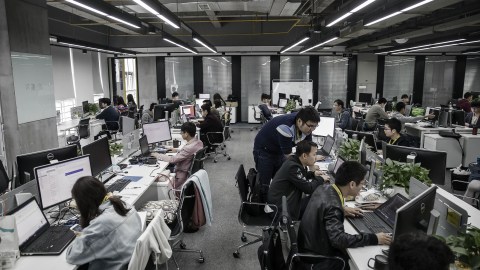Changing where you sit at work shown to boost creativity and innovation

Employees work at a Truck Alliance Inc. office in Chengdu, China, on Tuesday, April 11, 2017. Photographer: Qilai Shen/Bloomberg via Getty Images
- Carnegie Mellon assistant professor, Sunkee Lee, found that rearranging workstations led to higher profits and better communication.
- Companies that only focus on short-term profits instead of long-term goals are less likely to innovate and grow.
- Opening up new dialogues between workers resulted in greater problem solving and fewer problems.
Many years ago, I attended a yoga class in the Upper East Side. My first time practicing with this particular teacher, I arrived early and unrolled my mat. A few moments later, another student informed me that I was in another member’s “spot,” and that she would be upset to find me there. The teacher verified this. I moved my mat, crisis avoided.
Obviously this is not a crisis. In fact, the teacher became a good friend and the student began attending my classes as well. (Considering I faced a different direction in that studio, she had to find another spot.) Yet I have legitimately watched meltdowns in classes when regulars do not get their “spot.” I’ve even watched grown adults leave the studio when they couldn’t get their way.
Whatever is happening in that person’s life, it goes well beyond the placement of a yoga mat. Studios serve as places of refuge; they should not provoke further anxiety. As with any sanctuary, the people, not the space, is what really matters. For years I’ve pushed students to leave their comfort zone, be it in yoga, cycling, kettlebells—breaking out of the workout rut (doing the same workouts, week after week) is a terrible way to exercise, unless you’re training for a marathon or another specific goal.
We love dependability. Yet we should counter with novelty. Shifting your physical location might reveal new insights. Not being beside a wall means you have to stop relying on it for balancing postures. A skillset is strengthened. Moving from the back to the front row forces you to acquire better listening skills instead of watching people in front of you. The possibilities for growth are endless.
Igniting creativity to transform corporate culture: Catherine Courage at TEDxKyoto 2012
This doesn’t only apply to gyms. A new study, published in Organization Science, found the same to be true of the work environment. By rearranging workers so that they sit closer to employees they never previously interacted with, Sunkee Lee, an assistant professor at the Tepper School of Business at Carnegie Mellon University, discovered that creative output—and profits—increased.
Rearranging sixty sales employees at a South Korean e-commerce firm, Lee observed that employees forced to sit next to colleagues they did not know allowed them to engage in more risk-taking and experimentation. These employees also made more money for the company. No revenue increase for the control group, however.
Lee notes that companies often promote “exploration,” yet it is counter to human nature. We’d rather coast along on what we know than explore what we do not. This has led to an actual emphasis on exploitation behaviors, such as efficiency, execution, and refinement—all great for short-term profits. In the long run, as any successful business owner knows, exploration is necessary. A practice as simple as shuffling workstations reminds us of the dangers of complacency.
As Lee says,
“Companies have to always prepare for the next big thing. The problem is that many ideas never even make it to the market, and that failure is an essential part of exploration.”

Photo by Alex Kotliarskyi on Unsplash
Reasons for this uptick in exploration behaviors are so basic it’s astounding they’re overlooked: conversations lead to insights for developing new ideas and anecdotes shared about previous failures. By opening the conversation to a wider selection of your workforce, data and experiences are shared, integrated, and implemented.
There is no utopia. Lee sketched a few problems with shuffling, including higher rates of distraction, privacy infringements, and quicker dissemination of germs. For companies that require productivity over innovation, playing musical chairs with employees might not be in their best interest. Likewise, forcing introverts to interact might stunt personal work habits.
That said, there is an unfortunate but applicable use case exhibiting similar results: trauma. The loss of a loved one is tragic. Yet it forces you to investigate reality differently. Depression can result, but so can reinvention. “Shaking things up” occurs when we have no choice; it can also occur by choice.
Stretching out of your comfort zone is never easy. Time and again, it’s shown to produce positive results, be it in a gym or office. This wisdom can only be learned through experience.
—
Stay in touch with Derek on Twitter and Facebook.





